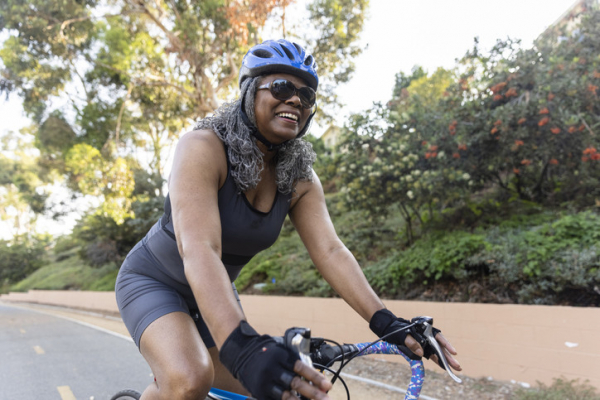
My favorite summer activities officially kick in when the calendar flips to May. It's prime time for open water swimming, running, cycling, hiking, and anything else that gets me outside and moving. Yet, my first step is to get my legs in shape.
“Legs are the foundation for most activities,” says Vijay Daryanani, a physical therapist at Harvard-affiliated Spaulding Rehabilitation Hospital. “They're home to some of the body’s largest muscles, and building healthy legs can improve one’s performance, reduce injury, and increase endurance.”
Four leg muscle groups to build for summer activities
Four muscles do the most leg work: quadriceps, gluteus maximus (glutes), hamstrings, and calves. Here is a look at each.
Quadriceps (quads). Also known as the thigh muscles, the quads are a group of four muscles (hence the prefix "quad'). They extend your leg at the knee and power every leg action: stand, walk, run, kick, and climb.
Glutes. The body’s largest muscles, the glutes (your buttock muscles) keep you upright and help the hips and thighs propel your body forward.
Hamstrings. The hamstrings are a group of three muscles that run along the back of your thighs from the hip to just below the knee. They allow you to extend your leg straight behind your body and support hip and knee movements.
Calves. Three muscles make up the calf, which sits in the back of the lower leg, beginning below the knee and extending to the ankle. They work together to move your foot and lower leg and push you forward when you walk or run.
Spotlight muscle strength and length
Strength and length are the most important focus for building summer-ready legs, says Daryanani. “Strengthening leg muscles increases power and endurance, and lengthening them improves flexibility to protect against injury.”
If you are new to exercise or returning to it after time off, first get your legs accustomed to daily movement. “Start simply by walking around your home nonstop for several minutes each day, or climbing up and down stairs,” says Daryanani.
After that, adopt a walking routine. Every day, walk at a moderate pace for 20 to 30 minutes. You can focus on covering a specific distance (like one or two miles) or taking a certain number of steps by tracking them on your smartphone or fitness tracker. You won’t just build leg strength — you’ll reap a wide range of health benefits.
There are many different leg muscle-building exercises, some focused on specific activities or sports. Below is a three-move routine that targets the four key leg muscles. Add them to your regular workout or do them as a leg-only routine several times a week. (If you have any mobility issues, especially knee or ankle problems, check with your doctor before starting.)
To help lengthen your leg muscles and increase flexibility, try this daily stretching routine that includes several lower-body stretches.
Dumbbell squats
Muscles worked: glutes and quads
Reps: 8-12
Sets: 1-2
Rest: 30-90 seconds between sets
Starting position: Stand with your feet apart. Hold a weight in each hand with your arms at your sides and palms facing inward.
Movement: Slowly bend your hips and knees, leaning forward no more than 45 degrees and lowering your buttocks down and back about eight inches. Pause. Slowly rise to an upright position.
Tips and techniques:
- Don’t round or excessively arch your back
Make it easier: Do the move without holding weights.
Make it harder: Lower yourself at a normal pace. Hold briefly. Stand up quickly.
Reverse lunge
Muscles worked: quads, glutes, hamstrings
Reps: 8-12
Sets: 1-3
Rest: 30-90 seconds between sets
Starting position: Stand straight with your feet together and your arms at your sides, holding dumbbells.
Movement: Step back onto the ball of your left foot, bend your knees, and lower into a lunge. Your right knee should align over your right ankle, and your left knee should point toward (but not touch) the floor. Push off your left foot to stand and return to the starting position. Repeat, stepping back with your right foot to do the lunge on the opposite side. This is one rep.
Tips and techniques:
- Keep your spine neutral when lowering into the lunge.
- Don't lean forward or back.
- As you bend your knees, lower the back knee directly down toward the floor with the thigh perpendicular to the floor.
Make it easier: Do lunges without weights.
Make it harder: Step forward into the lunges, or use heavier weights.
Calf raises
Muscles worked: calves
Reps: 8-12
Sets: 1-2
Rest: 30 seconds between sets
Starting position: Stand with your feet flat on the floor. Hold on to the back of a chair for balance.
Movement: Raise yourself up on the balls of your feet as high as possible. Hold briefly, then lower yourself.
Make it easier: Lift your heels less high off the floor.
Make it harder: Do one-leg calf raises. Tuck one foot behind the other calf before rising on the ball of your foot; do sets for each leg. Or try doing calf raises without holding on to a chair.
About the Author

Matthew Solan, Executive Editor, Harvard Men's Health Watch
Matthew Solan is the executive editor of Harvard Men’s Health Watch. He previously served as executive editor for UCLA Health’s Healthy Years and as a contributor to Duke Medicine’s Health News and Weill Cornell Medical College’s … See Full Bio View all posts by Matthew Solan
About the Reviewer

Howard E. LeWine, MD, Chief Medical Editor, Harvard Health Publishing
Dr. Howard LeWine is a practicing internist at Brigham and Women’s Hospital in Boston, Chief Medical Editor at Harvard Health Publishing, and editor in chief of Harvard Men’s Health Watch. See Full Bio View all posts by Howard E. LeWine, MD
